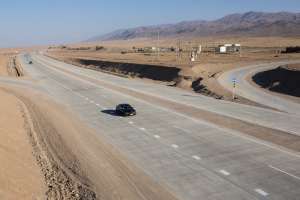
One of the striking lessons from Asia’s success over the past few decades is that it makes economic sense to invest in regional infrastructure to link two or more countries to support outward-oriented development strategies.
Cross-border projects such as the Almaty-Bishkek regional road in Central Asia, the India-Bangladesh Electrical Grid Interconnection project, and the Tonga-Fiji Submarine Cable have enhanced Asia’s economic development by stimulating flows of goods, services, investment, people and technology. They have also fostered regional peace and cooperation. Negative effects such as environmental degradation, displaced people, crime and trafficking from such projects have been largely mitigated through safeguards and public policies.
A huge gap exists, however, between the enormous demand for investment in regional infrastructure and inadequate supply of infrastructure finance in Asia, which has led to the recent emergence of several competing mega-regional infrastructure initiatives supported by different players. Some major initiatives are Japan’s $100 billion Partnership for Quality Infrastructure; the PRC’s One Belt, One Road initiative financed by the $40 billion Silk Road Fund and $100 billion in commitments from other initiatives; and ASEAN’s Master Plan for Connectivity, financed through the $500 million ASEAN Infrastructure Fund. Financial commitments for South Korea’s EurAsia Initiative, the EU Investment Plan, and Russia’s Trans-Eurasian Belt Development are yet unknown.
It is still early days for mega-regional infrastructure initiatives in Asia. Some appear better designed than others; with deep project management, high-quality engineering solutions, strong buy-in from recipients, and sizable financial commitments. As good management, engineering, and donor practices spread, laggard initiatives may well emulate their predecessors, and a coherent architecture of mega-regional infrastructure initiatives could eventually emerge in Asia.
But multiple and overlapping initiatives in Asia also risk creating a “noodle bowl” phenomena more usually associated with free trade agreements, which bring high transactions costs for economies and business. Clearly, many common attributes as well as differences do exist between these regional infrastructure initiatives including in terms of their vision, ambition, time horizons, financial commitments, cofinancing approaches, and implementation strategies. For instance, several initiatives are looking to establish cross-border transport links in prosperous Southeast Asia, albeit with different plans and financing.
The threat of an Asian noodle bowl of mega-regional infrastructure initiatives may be exacerbated by the following factors:
1. Scarce finance may be packaged in a way which could make the noodle bowl effect more pronounced.
Asia’s has an estimated $8 trillion in infrastructure development needs and limited commitments to date of about $350-$400 billion. Recipients and donors want to stretch limited funds through innovative financial means such as cofinancing regional projects with development agencies; state guarantees to incentivize private investors; fully-fledged public private partnerships; re-packing of various financing instruments; and crowdfunding. Governments will also need to increase spending for regional infrastructure projects in national budgets.
2. Mega-regional infrastructure initiatives will likely create winners and losers in Asia.
Winners arise when initiatives (i) reinforce comparative advantage reflected in trade and investment patterns in Asia to avoid the risk of building “roads and power lines to nowhere”; (ii) are backed by open regionalism initiatives and domestic economic reforms; (iii) build in adequate safeguards (e.g. for the environment and resettlement) in formulating projects; and (iv) coordinate among themselves in key areas such as planning, project formulation, procurement practices, financing and implementation.

Losers from initiatives are hard to predict, as the devil is in the details of specific projects. However, landlocked countries like Nepal or Uzbekistan, or island nations such as those in the Pacific, the Maldives or Timor-Leste that may not be a part of mega-regional infrastructure initiatives may be marginalized. Some transport routes (land vs. maritime transport) and port workers may also lose out. Ironically, the quest to maximize the benefits of mega regional infrastructure measures could also, thus, contribute to the noodle bowl. To avoid that, the region could consider offsetting measures to mitigate the negative impacts of such initiatives through creating Asian variants of the European Union’s regional development funds to address regional development imbalances.
3. Mega-regional infrastructure initiatives may pose risks to the debt sustainability, governance, and transparency of participating countries.
Poorer developing countries, with weaker financial capacity and governance, may be more susceptible to these risks than richer developing countries, possibly increasing differences between them.
The more initiatives, the greater the risks. Prudent debt management and capacity building are essential to mitigating these risks. Clear analysis of benefits and costs of individual mega-regional infrastructure initiatives, policy dialogue among those involved in them, and project-level coordination will help minimize duplication and the risk of an Asian noodle bowl of infrastructure initiatives. Asian players and others deserve credit for trying to tackle the region’s problem of infrastructure financing. But more time is needed to ensure that mega-regional infrastructure initiatives produce only net benefits for developing Asia.
This article was first published by ADB Development Blog.







Comments are closed.